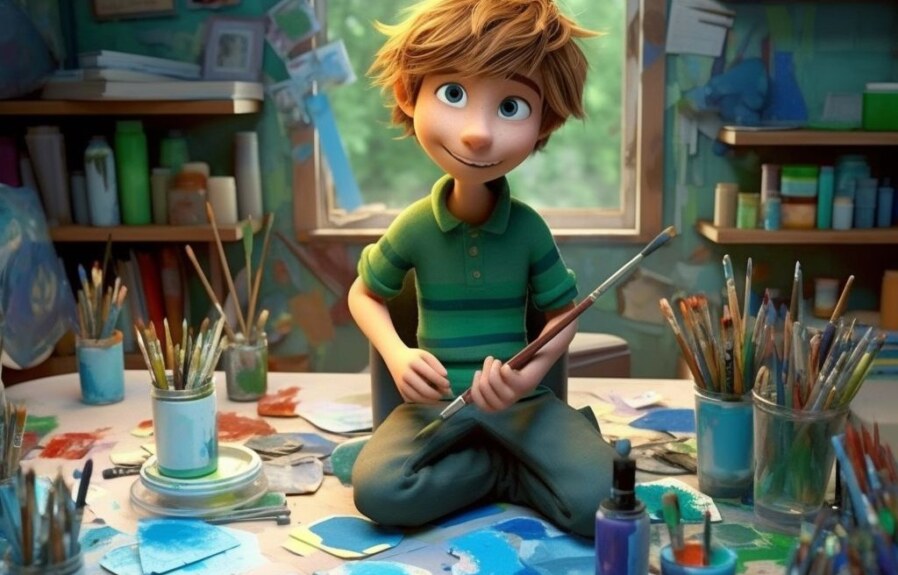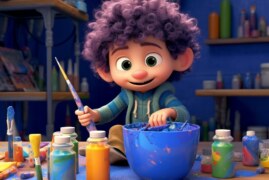Teal is a beautiful and versatile color that can add a touch of sophistication to any art or design project. However, many artists and designers are perplexed by the process of making this color. With so many shades of blue and green available, achieving the perfect blend can be a daunting task. But fear not, as an expert in Art & Design, I will guide you through the process of making the elusive teal shade. Whether you are a beginner or a seasoned artist, this informative article will provide you with valuable insights on how to create different variations of this stunning color. So, pick up your paintbrushes, and let’s get started!
1. Understanding the Color Theory: The Basics of Teal
Teal is a unique hue that falls somewhere between blue and green on the color spectrum. The color gets its name from the blue-green shade that can be found on the plumage of ducks known as “teals”. In the world of art and design, teal is a popular color choice as it represents a balance of calmness, stability, and creativity.
To create the perfect teal shade, it is important to have a good grasp of the color theory. Understanding the basics of color theory will help you create the ideal shade of teal and other colors in the future.
Color theory is built on three primary colors: red, blue, and yellow. All other colors consist of a mix of these three colors. Secondary colors are made by mixing two primary colors. For instance, mixing blue and yellow creates green. The tertiary colors are made by blending primary and secondary colors in various proportions.
Teal is a tertiary color that is created by mixing blue and green. The shade of teal depends on the proportions of blue and green used in the mix. It is worth noting that teal can also be created by mixing secondary colors. For example, mixing blue and green can create a bluish-green shade that can be adjusted to achieve the perfect teal hue.
Understanding the color theory can help you create endless shades of teal by using different hues of blue and green. In the next section, we will discuss the science behind color mixing and how to create teal using primary colors.
2. The Science behind Color Mixing: How to Create Teal Using Primary Colors
How To Make Teal: The Science Behind Color Mixing
Teal is a complex color that is often used in art and design projects. Understanding how to create teal using primary colors is essential for any artist or designer. In this section, we will explore the science behind color mixing and reveal the secrets to achieving the perfect shade of teal.
The Color Wheel
To understand how to create teal, we must first understand the color theory. The color wheel is a tool that artists and designers use to understand how colors relate to each other. The primary colors are red, blue, and yellow, and they are the building blocks of all other colors. When two primary colors are mixed, they create a secondary color. For example, mixing blue and yellow creates green.
Mixing Primary Colors to Create Teal
To create teal, you will need to mix blue and green. However, not all blues and greens are the same, and using the wrong shades can lead to an undesired result. It is best to use a true blue, such as ultramarine blue, and a yellow-green, such as lemon green. Mixing equal parts of these colors will create a vibrant, saturated teal that is ideal for many applications.
Adding White or Black
For a lighter or darker teal, white or black can be added to the mix. Adding white will create a lighter shade of teal known as a tint, while adding black will create a darker shade known as a shade. It is important to note that adding too much white or black can alter the hue of the teal, so it is best to add these colors in small amounts and adjust accordingly.
Understanding the science behind color mixing is essential for any artist or designer. By following these tips and experimenting with different shades, you can achieve the perfect shade of teal for any project.
3. Mixing Paints: Step-by-Step Guide to Achieving the Perfect Teal Hue
How To Make Teal
Teal is a beautiful greenish-blue color that is widely used in art and design. Mixing paints to create the perfect teal hue can be tricky, but with the right combination of primary colors, you can achieve the perfect shade of teal. Here is a step-by-step guide to mixing primary colors to create teal.
Step 1: Gather Your Supplies
Before you start mixing paints, make sure you have all the supplies you need. You will need primary colors, such as blue, yellow, and red, a palette or mixing tray, and a paintbrush.
Step 2: Start with the Base
Begin by mixing equal parts blue and green to create the base of your teal color. You want to make sure you have an even mixture of both colors in order to create a solid base for your teal. Start with small quantities, and add more colors as needed until you achieve the right shade.
Step 3: Add Yellow
Next, add a small amount of yellow to your blue-green mixture. This will help brighten your teal color and make it more vibrant. Be sure to mix well and test the color on a white surface to make sure it is the right shade.
Step 4: Adjusting the Hue
If your teal color is too green, add more blue to the mix. If it’s too blue, add more green. Keep adding small amounts of each color until you achieve the perfect hue. Don’t be afraid to experiment with different proportions to achieve the shade you’re looking for.
Remember to mix your colors well and test your teal on a white surface to make sure it’s the right shade. With a little patience and practice, you can mix the perfect teal color.
4. Alternative Methods: Creating Teal Shade with Dye, Ink or Digital Software
How To Make Teal
Mixing dye and ink: Creating the perfect teal shade can be accomplished using dyes or inks. Teal dye is readily available at craft stores or online, and with a bit of mixing, you can achieve the desired shade. For example, mixing 1 part turquoise dye with 2 parts navy blue dye can result in a beautiful teal color. Similarly, mixing cyan, magenta, and yellow ink in proportionate amounts can also produce a teal hue. Be sure to test the color mixture on a sample fabric or paper to check for the desired shade.
Working with digital software: Digital software is an excellent tool for creating and manipulating colors. Adobe Photoshop, Illustrator, and InDesign are just a few examples of software that can be used to create custom colors. To create teal digitally, one can start with a base color, like blue or green, and adjust the hue and saturation until the desired teal tone is achieved. Additionally, some software also has preset color palettes that include teal shade, making it easier to choose the perfect tone.
Using fabric paints: Fabric paints are another alternative for creating a particular color. The process involves adding the paint to the fabric using a brush or stenciling technique. To create teal fabric paint, mix a small amount of blue paint with green paint until the desired shade of teal is achieved. Remember to experiment with various shades, as some teal colors may appear different on different types of fabric.
By exploring alternative methods, you can create beautiful shades of teal using dyes, inks, digital software, or fabric paints. Each technique has its own unique advantages, and you can choose the method that best suits your needs. With a bit of practice and experimentation, you’ll be able to create the perfect teal color for your next project.
5. Practical Tips: Avoiding Common Mistakes in Creating Teal and Achieving Consistent Results
Achieving the perfect teal can be a challenging endeavor, but with a little bit of practice and attention to detail, you can achieve consistent results every time. Here are some essential practical tips to help you avoid common mistakes in creating teal.
Avoid Using Too Much Green Paint
One of the most common mistakes when making teal is using too much green paint. This can result in a greenish-blue hue, rather than the deep bluish-green color of true teal. To prevent this from happening, start with very small amounts of green paint and gradually add more until you achieve the desired shade of teal. Remember, you can always add more, but it is difficult to remove excess paint once it has been mixed into your color.
Use High-Quality Paints
The quality of your paints will have a significant impact on the final result of your teal hue. Cheaper paints may contain impurities or inconsistent pigments that can affect the color and appearance of your teal. It is advisable to invest in high-quality, professional-grade paints to ensure that you achieve consistent results every time. You can also conduct research on brands that are highly recommended by artists and experts in the field.
Keep a Record of Your Mixing Ratios
To achieve consistent results, it is vital to keep track of the ratio of paint used in each batch. This can be easily done by using measuring spoons or scales to weigh the amount of paint used. Keeping a record of your mixing ratios will allow you to recreate your perfect shade of teal with ease. Additionally, if you run out of paint mid-project, you can use the ratios to recreate the color more accurately.
By following these practical tips, you can avoid common mistakes when creating teal and achieve consistent results every time. With the right amount of practice and patience, you can create beautiful works of art that feature the stunning bluish-green color of teal!
People Also Ask
1. What colors make up teal?
Teal is made up of a combination of blue and green pigments. The blue pigment is usually more dominant, making it more similar to a blue-green color.
2. How do you mix teal with paint?
To mix teal with paint, you will need to mix together blue and yellow paint to create green. Add more blue than yellow to the mixture to make a darker, more blue-leaning green. Mix the green paint with blue paint until you achieve the desired shade of teal.
3. What is the hex code for teal?
The hex code for teal is #008080. This code represents equal amounts of red, green, and blue values in the color spectrum.
4. What is the difference between teal and turquoise?
Teal is a darker, more blue-leaning green, while turquoise is brighter and more saturated. Teal can also have a slightly more muted quality to it, while turquoise is more vibrant.
5. Can you make teal by mixing other colors besides blue and green?
While blue and green are the primary colors used to make teal, you can experiment with mixing other colors to create different shades of teal. For example, adding a touch of yellow to blue-green can create a warmer, brighter shade of teal.
Conclusion
Teal is a beautiful color and is often used in various art forms and home decor. To make teal, you need a combination of blue and green pigments. And, by following some simple steps, you can create this color on your own. Mixing teal with other colors and experimenting with hues can help you achieve unique and personalized shades of teal.



